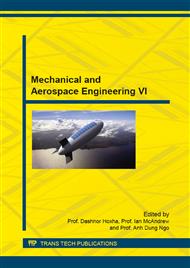[1]
Morozov E V, de la Beaujardiere J F P. Numerical simulation of the dynamic thermostructural response of a composite rocket nozzle throat[J]. Composite Structures, 2009, 91(4): 412-420.
DOI: 10.1016/j.compstruct.2009.04.006
Google Scholar
[2]
Shivakumar K N, Cozart A. Analysis of 3-D Braided Composite Ablative Rocket Nozzle[C]. ASME, (2002).
DOI: 10.1115/fedsm2002-31422
Google Scholar
[3]
Mehta, Suresh, Narayana Lyer. Thermal stress analysis of a solid rocket motor nozzle throat inserts using finite element method[J]. India Journal of Engineering & Materials Sciences, 1998, 5(5): 271-277.
Google Scholar
[4]
Daniele Bianchi, Francesco Nasuti, Emanuele Martelli. Coupled Analysis Flow and Surface Ablation in Carbon–Carbon Rocket Nozzles[J]. Journal of Spacecraft And Rockets. 2009, 46(3): 492-50.
DOI: 10.2514/1.40197
Google Scholar
[5]
Kuo. A Comprehensive Theoretical Model for Carbon-Carbon Composite Nozzle Recession. Combust[J]. Sct. and Tech, 1985, 42(3): 145-16.
Google Scholar
[6]
Keswani, Andiroglu, Campbell, Kuo. Recession Behavior of Graphitic Nozzles in Simulated Rocket Motors[J]. Journal of Spacecraft and Rockets, 1984, 22(4): 396-397.
DOI: 10.2514/3.25763
Google Scholar
[7]
Chen Ruxun. Solid Rocket Motor Design And Study [M]. China Astronautic Publishing House, (1991).
Google Scholar
[8]
Tian Sipeng, Tang Guojin, etc. Gap Design of Solid Rocket Motor Nozzle Structures[J]. Journal of Propulsion Technology, 2005, 26(5): 448-451.
Google Scholar
[9]
Tian Sipeng, Tang Guojin, etc. Analysis on Nozzle Structure Integrality of Solid Rocket Motors[J]. Journal of Solid Rocket Technology, 2005, 28(3): 180-183.
Google Scholar
[10]
ANSYS INC. Release 14. 0 Documentation for ANSYS [M]. ANSYS, Inc press (2012).
Google Scholar
[11]
R. Carl Stechman, Joelee Oberstone, J. C. Howell. Film Cooling Design Criteria For Small Rocket Engines[J]. AIAA 1962-665.
Google Scholar
[12]
Wang Yanan, Wang Zhaoyi. Study on Assembly Manufacturability for A Nozzle[J]. Mechanical Engineer, 2014, (6).
Google Scholar
[13]
China Aeronautical Materials Handbook Committee. China Aeronautical Materials Handbook[M]. Vol 8, edition2, Standard Press of China, 443-448.
Google Scholar


